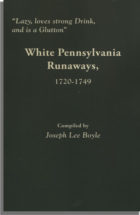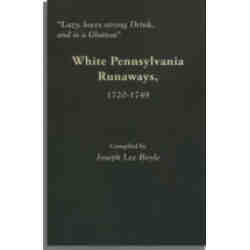The demand for labor in the colonial period was such that by 1775 an estimated 350,000 to 500,000 indentured persons had been transported to America. The majority of these individuals were indigent, eager for a better life in the New World and willing to work off the cost of their passage by reimbursing ships’ captains or others by the sweat of their brow. Other servants–especially after England’s Transportation Act of 1718 opened the floodgates for exiled criminals–were in America to work off their prison sentences. This combined labor pool was vital to economic life of the Middle Colonies, including Pennsylvania, which received a significant population of German servants, also known as redemptioners.
Whatever the motivation, runaway servants were not an uncommon phenomenon in the 18th century. One source estimates that between 20-25% of indentured servants fled their masters. From the genealogist’s standpoint, this presents a methodological problem since it was in the runaway’s best interest to conceal his/her identity after making a successful getaway. In other words, even if the runaway kept the same name, it is quite likely that the link to his original residence in America and to his country of origin was lost–lost, that is, unless his/her identity is uncovered in the thousands of runaway ads placed in colonial newspapers by the disgruntled “owners.” And this is precisely where the research and publications of Joseph Lee Boyle come in.
Since 2009 Joseph Boyle has compiled five volumes of runaway servant ads for the Chesapeake region. In the process he has combed scores of 18th-century newspapers for references to missing servants. After publishing three collections of runaway servant ads pertaining to Maryland runaways from 1720 through 1774, and a single volume on Delaware for 1720-1783, he has now moved on to Pennsylvania. This book, the first in a series, is “Lazy, loves strong Drink, and is a Glutton”: White Pennsylvania Runaways, 1720-1749.
As Mr. Boyle points out in his very helpful introduction, Pennsylvania received one-tenth of all male indentured servants from the 1720s through the 1740s, and about one-fifth of the women in that period. According to one authority, over 67,000 German immigrants arrived at the busy port of Philadelphia from 1720 through 1760, at least half of whom were servants. Mr. Boyle’s transcription of the runaway ads, taken from seventeen different colonial newspapers (and not just Pennsylvania ones), provide valuable demographic information on more than 3,000 individuals, with name, age, sex, height, plate of origin, clothing, occupation, speech, physical imperfections, and sometimes personal vignettes. For this compilation the author has listed only white male and female runaways; however, for those ads where white and black runaways are listed together, blacks are so identified in the index at the back of the volume.


